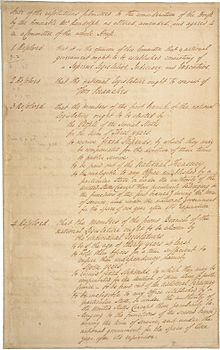Virginia Plan
| Virginia Plan | |
|---|---|

Front side of the Virginia Plan
|
|
| Created | May 29, 1787 |
| Location | National Archives |
| Author(s) | James Madison |
| Purpose | Propose a structure of government to the Philadelphia Convention |
The Virginia Plan (also known as the Randolph Plan, after its sponsor, or the Large-State Plan) was a proposal by Virginia delegates for a bicameral legislative branch. The plan was drafted by James Madison while he waited for a quorum to assemble at the Constitutional Convention of 1787. The Virginia Plan was notable for its role in setting the overall agenda for debate in the convention and, in particular, for setting forth the idea of population-weighted representation in the proposed national legislature.
The Constitutional Convention gathered in Philadelphia to revise the Articles of Confederation. The Virginia delegation took the initiative to frame the debate by immediately drawing up and presenting a proposal, for which delegate James Madison is given chief credit. However, it was Edmund Randolph, the Virginia governor at the time, who officially put it before the convention on May 29, 1787, in the form of 15 resolutions.
The scope of the resolutions, going well beyond tinkering with the Articles of Confederation, succeeded in broadening the debate to encompass fundamental revisions to the structure and powers of the national government. The resolutions proposed, for example, a new form of national government having three branches (legislative, executive and judicial). One contentious issue facing the convention was the manner in which large and small states would be represented in the legislature: proportionate to population, with larger states having more votes than less-populous states, or by equal representation for each state, regardless of its size and population. The latter system more closely resembled that of the Articles of Confederation, under which each state was represented by one vote in a unicameral legislature.
The Virginia Plan proposed a legislative branch consisting of two chambers (bicameral legislature), with the dual principles of rotation in office and recall applied to the lower house of the national legislature. Each of the states would be represented in proportion to their “Quotas of contribution, or to the number of free inhabitants.” States with a large population, like Virginia (which was the most populous state at the time), would thus have more representatives than smaller states. Large states supported this plan, and smaller states generally opposed it, preferring an alternative put forward on June 15. The New Jersey Plan proposed a single-chamber legislature in which each state, regardless of size, would have one vote, as under the Articles of Confederation. In the end, the convention settled on the Connecticut Compromise, creating a House of Representatives apportioned by population and a Senate in which each state is equally represented.
...
Wikipedia
